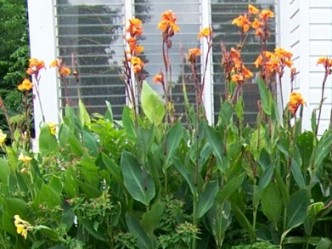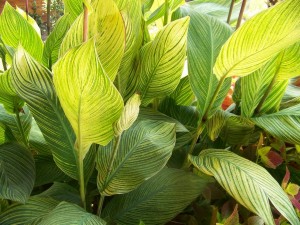|
Gardens Ablaze |
||
|
|
Canna |
|
|
Detailed Bulb Profiles Site Map
Home |
I first ran across canna when I was a beginning, broke, wanna-be gardener. I found a single plant growing behind an abandoned shed, and just had to have it. I dug it out and put it in my own garden, and the rest is history. See the picture of the orange cannas above? They are all descendents of that one original plant. But that picture doesn't tell the whole story. I have them on the sides of the house, the back of the house, the front of the house at the street, and jammed everywhere there is a suitable foot of earth. Every spring, I give enough tubers away to fill a wheelbarrow - and they just keep on coming. Now admittedly, in colder climates than my zone 7 garden, canna will not always return and multiply, but unless you are in a very cold place, mulching heavily in the fall might just keep them warm enough to stay viable. If not, you can dig them and store them, start them from seed in the spring, or just buy new tubers, which in my opinion is the easiest way. Try leaving them out under some mulch and see what happens. You never know until you try! Cannas prefer full sun, especially in the north. In the hot south, they will tolerate a good bit of shade in my experience. Too much shade, however, will weaken the plant making it susceptible to blowing over in strong winds. Truthfully though, big as they are, cannas sometimes get blown over in strong winds anyway. More than once, I have gone outside in the morning and found my beautiful cannas lying in a mess on the ground like pick-up sticks. The good news is that they rebound quickly and in the end it's not as big a disaster as it first appears. Cannas like decently drained soil and moderate water, but again, in my experience they will take a beating in far less than ideal circumstances and still do just fine. I had a patch during the worst drought ever in my area, and those plants didn't get any water at all from May until August in 100 degree heat, and they still looked pretty good and returned in force the next year.
Canna can be started from seed, but the outer seed coatings are hard and this makes germination take longer and not be as reliable. To get past this, I like to use sandpaper. Just rub the seed on a piece of sandpaper until you can just see the white inside and that's good enough. Then drop it into a glass of warm water for a day or two to soften the hard outer coating. If you forget about it for an extra day or three, it won't hurt anything. Drain the water and plant the seeds in potting soil and cover them shallowly. Put the pots in a sunny window and poof - plants will start coming up in a week or two. Be patient. Keep them in suitable-sized pots until they are big enough to withstand the outdoors (don't plant them outside in cold soil), and stand back. You can also buy tubers from the store, which is easier but more expensive. Just plant them in the ground and watch them explode. If your cannas like their position, they will multiply like rabbits. To divide, just use a sharp shovel and dig out what you need. The tubers are tough little devils, so if you are going to throw them away, don't just toss them into a corner of the yard unless you want cannas there too. One time I put some tubers mixed in with yard trimmings at the street for the truck to pick up, and now I have a nice little stand of canna there and nowhere to put yard trimmings for pick-up anymore. Cannas are not bothered by much as far as disease or bugs are concerned, although there is apparently a canna disease similar to rust that I have never seen in all my canna growing experience. Then there are slugs. They love the stuff. They will get on a leaf while it is still in a tight coil and chew all around it so that when the leaf unfurls, there is a symmetric pattern of chew marks all the way across it. This is more of a problem when the tuber has been overwintered in the ground, but can happen any time. Personally, I just live with it and hope that the underlying garden ecosystem is enough to keep the slugs somewhat in check, which appears to be the case in my garden. Cannas also tolerate contaminants well and will do just fine as a fast-growing buffer between you and a busy road or nosy neighbor. Cannas can be used as cut flowers if you need a nice short-term display for a special occasion or whatever. However, the flowers only last one day, so don't be surprised when your beautiful bouquet is a goner when you wake up after partying the night away. Lastly, for the crafty gardener, canna seed can be used as beads to make jewelry and other crafts. How about that for an idea!
Custom Search
|
|
|
Gardens Ablaze |
||
 For
those gardeners who like big plants and bold colors, there is really no
better choice for the mid to late summer garden than canna. Canna
is an essential for those going for a tropical look, makes a nice back of
border addition for layered beds, and even makes a memorable statement all
by itself. And canna is a deer resistant plant for those who have
local deer populations. Are you a beginning gardener or someone who
needs to fill a large garden bed quickly? Look no further because
you have just stumbled on a plant that you will have in your garden for
life. Is it easy to grow, you ask? Mark my words - get a tuber,
stick it in the ground, and stand back because the thing will barge out
of the ground and become huge almost before your eyes!
For
those gardeners who like big plants and bold colors, there is really no
better choice for the mid to late summer garden than canna. Canna
is an essential for those going for a tropical look, makes a nice back of
border addition for layered beds, and even makes a memorable statement all
by itself. And canna is a deer resistant plant for those who have
local deer populations. Are you a beginning gardener or someone who
needs to fill a large garden bed quickly? Look no further because
you have just stumbled on a plant that you will have in your garden for
life. Is it easy to grow, you ask? Mark my words - get a tuber,
stick it in the ground, and stand back because the thing will barge out
of the ground and become huge almost before your eyes! Canna
flowers come in most of the warm colors, such as red, salmon, orange, yellow,
and white. The hybridizers have been having fun with this plant recently,
and now you can get cannas with cool stripes on the leaves or with purple
or bronze foliage rather than just settling for green like I have.
I wish I could try out some of the new types, but my old ones have taken
up every square inch of canna space I have in my garden. I also have
yellow canna, which is not pictured here but which I like a lot. As
stated above, Canna will start blooming in mid to late summer, and will
go on pretty much until first frost. Deadheading is nice to encourage
new blooms, but is not absolutely necessary, especially if you have a lot
of plants. Before bloom time, the plants have nice, big, tropical-looking
foliage that contrasts nicely with the more finely cut leaves of shorter
plants in the front of the border.
Canna
flowers come in most of the warm colors, such as red, salmon, orange, yellow,
and white. The hybridizers have been having fun with this plant recently,
and now you can get cannas with cool stripes on the leaves or with purple
or bronze foliage rather than just settling for green like I have.
I wish I could try out some of the new types, but my old ones have taken
up every square inch of canna space I have in my garden. I also have
yellow canna, which is not pictured here but which I like a lot. As
stated above, Canna will start blooming in mid to late summer, and will
go on pretty much until first frost. Deadheading is nice to encourage
new blooms, but is not absolutely necessary, especially if you have a lot
of plants. Before bloom time, the plants have nice, big, tropical-looking
foliage that contrasts nicely with the more finely cut leaves of shorter
plants in the front of the border.